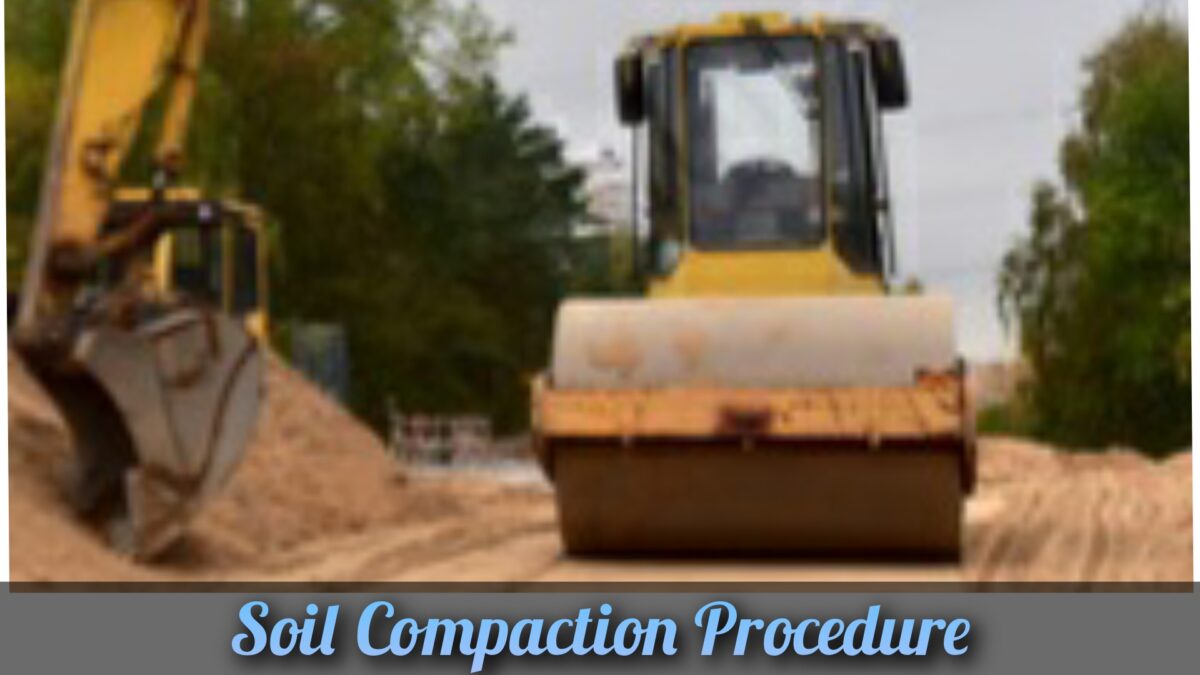Soil compaction is a crucial procedure in construction that involves increasing the density of soil to improve its load-bearing capacity and reduce settlement.

Compacted soil provides a stable foundation for various structures such as buildings, roads, and bridges.
I have described a typical soil compaction procedure in construction.
Table of Contents
Step By Step Soil Compaction Procedure
Here is a general procedure for soil compaction in construction projects:
- Soil Analysis: Conduct a thorough analysis of the soil to determine its properties, including moisture content, composition, and compaction characteristics. This analysis helps determine the appropriate compaction method and equipment to use.
- Moisture Adjustment: Soil moisture content plays a vital role in achieving optimum compaction. If the soil is too dry, it may not compact properly, while excessive moisture can lead to poor compaction. Adjust the moisture content of the soil to achieve the desired compaction characteristics.
- Site Preparation: Clear the construction area of any debris, vegetation, or other unwanted materials. Level the ground and remove any large rocks or obstructions that could hinder the compaction process.
- Compaction Equipment Selection: Choose the appropriate compaction equipment based on the soil type and project requirements. Commonly used equipment includes vibratory rollers, smooth-wheel rollers, sheepsfoot rollers, and plate compactors.
- Compaction Method: The compaction method depends on the soil type and equipment used. Typically, the compaction is achieved by applying repeated passes of the compaction equipment over the soil surface. The equipment exerts pressure on the soil, causing particles to rearrange and reducing air voids.
- Lift Thickness: Soil is compacted in layers or lifts, with each layer having a specific thickness. The thickness of the lift depends on the compaction equipment being used. Generally, for large vibratory rollers, the lift thickness can range from 15 to 30 cm (6 to 12 inches). For smaller compactors, the lift thickness may be smaller.
- Compaction Testing: Regularly test the compacted soil to ensure it meets the desired compaction specifications. Test methods include the Proctor test or Modified Proctor test, which measure the maximum density and optimum moisture content of the soil.
- Quality Control: Monitor the compaction process to maintain quality control. Adjust the compaction parameters, such as moisture content or number of passes, if necessary, to achieve the desired level of compaction.
- Documentation: Keep detailed records of the compaction process, including test results, equipment used, and any adjustments made during the compaction. These records are essential for quality assurance and may be required for future reference.
Benefits Of Soil Compaction In Construction Projects
1. Increased Load-Bearing Capacity:
Compacting the soil increases its density and improves its load-bearing capacity. This is particularly important for projects involving structures such as buildings, roads, and foundations. Compacted soil can support heavy loads without excessive settlement or deformation.
2. Improved Stability:
Compaction enhances the stability of the soil by reducing its susceptibility to settlement, settling, or shifting. It helps prevent differential settlement, which can lead to structural damage or uneven surfaces.
3. Enhanced Ground Strength:
Compacted soil has increased shear strength, making it more resistant to failure under applied forces. This is beneficial for projects where stability and resistance to erosion are essential, such as embankments, slopes, or retaining walls.
4. Better Drainage:
Compaction reduces soil porosity, limiting the space available for water to accumulate. It promotes better drainage by increasing the soil’s permeability, allowing water to flow through more easily. Improved drainage helps prevent waterlogging and related problems, such as erosion or damage to structures.
5. Mitigation of Shrinkage and Swelling:
Some soils, such as clay, can undergo significant volume changes due to moisture fluctuations. Compacting these soils helps reduce their susceptibility to shrinkage and swelling, minimizing the risk of damage to foundations or pavements caused by soil movement.
6. Minimized Settlement:
Proper compaction reduces the potential for settlement over time. By compacting the soil adequately during construction, the amount of settlement that may occur after the completion of a project is minimized. This is particularly important for projects that require long-term stability, such as highways or airports.
7. Cost Savings:
Soil compaction can lead to cost savings in construction projects. By compacting the soil, the need for additional soil fill or structural reinforcements may be reduced. It also helps ensure the longevity of the constructed infrastructure, minimizing future maintenance and repair costs.
Closing Thought
Soil compaction procedure may vary depending on the project requirements, soil conditions, and local regulations.
Taking advice from a geotechnical engineer or a qualified professional is recommended to ensure the appropriate compaction process for a specific construction project.
Faqs
To determine the best moisture content for soil compaction, you need to do some tests in a lab. The Proctor test or modified Proctor test is commonly used. These tests involve compacting soil samples with different moisture levels and measuring their densities to find the optimum moisture content.
Yes, you can compact different types of soil, including clay and sand. However, the way you compact them may vary. Clay soil usually requires more effort and moisture control compared to sandy or gravelly soil.
Not every construction project requires soil compaction, but it’s generally recommended for structures that need a stable foundation. Buildings, roads, embankments, pavements, and other infrastructure projects often require compaction. The need for compaction depends on factors like soil type, load-bearing requirements, and the potential for settling.
It’s generally not recommended to compact soil when it’s wet or frozen. Wet soil with high moisture content is difficult to compact effectively. Frozen soil is also unsuitable for compaction since the particles are locked and can’t be rearranged properly. It’s better to wait for the soil to dry or thaw before attempting compaction.
Poor soil compaction can cause various problems. Some common signs include structures settling too much or unevenly, cracking or unevenness in pavements, and poor drainage. If you notice these signs, it’s important to assess the soil compaction and take necessary measures to ensure the stability and durability of the construction project.
